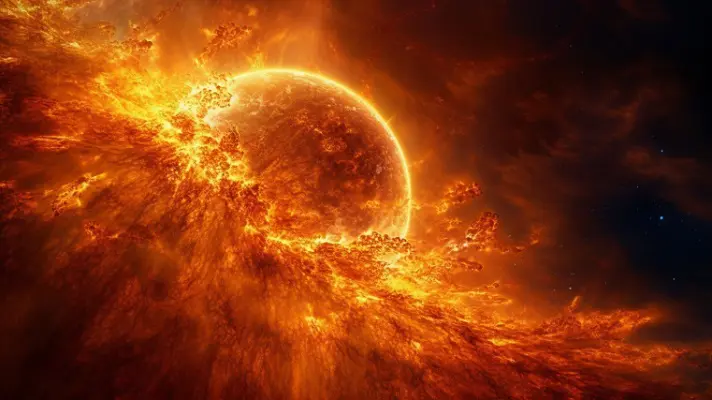
Greetings, esteemed reader. Once more, we stand on the brink of the unfathomable abyss that is the universe. Amidst the cosmic swirl, celestial bodies pirouette in their silent ballet, occasionally underscored by phenomena so grand, they shatter the very status quo.
One such spectacle is our point of intrigue today — the voracious consumption of a planet by its progenitor star. A tale largely shrouded in cosmic mystery until now, made palpable by the ceaseless pursuit of human curiosity. As we delve into this narrative, let us not forget our humble home — the Earth and the Sun, mere dancers in this grand cosmic choreography.
The Encounter: An Astronomer’s Curiosity
Our tale commences with the attentive observation of one Kishalay De, an astronomer of repute from MIT. His celestial radar zeroed in on a star, 12,000 light-years yonder in the constellation Aquila. This star presented an extraordinary display, intensifying its luminosity a hundredfold within a week — a performance so astounding, it would leave any conventional nova wallowing in envious despair. The Zwicky Transient Facility, ever watchful sentinel of the sky, made us privy to this spectacle.
The Conundrum: A Cosmic Riddle Unfurls
De found himself ensnared in a cosmic enigma. At first blush, one might have assumed a stellar merger. However, this theory was promptly shelved. The oddity lay in the evidence — cool gas and molecules, customarily residing in the frosty outskirts of merging stars, encircled our star. This painted a perplexing picture. After all, such frosty environs usually signal stellar mergers, not planetary feasts.
Desperate to shed light on this paradox, De enlisted the aid of the Palomar Observatory. Its infrared optics proffered a glimpse into the cooler aspects of the celestial drama. The star had, rather intriguingly, engendered an impressive amount of dust. De’s hypothesis gained traction when NEOWISE, NASA’s infrared space telescope, disclosed a startlingly minute total energy emission from the star since its luminous outburst, a mere fraction of the energy output associated with any known stellar merger.
The Consumption: A Cosmic Maw Revealed
Armed with these cosmic breadcrumbs, De postulated that our star had feasted, not on a star, but on a planet. The interstellar victim was likely 1 to 10 times the mass of Jupiter, and its predator, a star akin to our own Sun, albeit with a mass between 0.8 to 1.5 times as great. Quite a cosmic banquet indeed! This event loosed upon the universe hydrogen equivalent to 33 times the mass of our Earth, and dust equal to a third of Earth’s mass, all jettisoned into the cosmos during the planet’s dissolution.
The Ramifications: A Warning from the Cosmos
Reflect now on our familiar solar system. Our Sun, gradually warming, and our Earth, perilously situated. Our home star will inevitably mirror the star of Aquila, swelling to a monstrous size. It is not beyond the realm of possibility that our Earth could share the fate of the devoured planet. The aftermath also holds implications for the star: did the planetary meal taint it with foreign material or did the energy exchange affect its rotation?
Questions for the Future: Cosmic Mysteries to Unravel
Such a monumental observation necessitates a plethora of questions: Was the planet completely annihilated, or did a remnant survive its fiery plunge? Did the star’s natural expansion instigate this event, or did an external force push the planet towards its star? These queries serve as navigational beacons for future exploration, providing a framework for understanding how planets influence their host stars and a pathway towards new discoveries.
The Conclusion: Cosmic Transience, a Stark Reality
As we recede from our astronomical stage, we’re left awestruck by the cosmic spectacle, a stark reminder of our universal insignificance. In the grand ballet of the cosmos, we are mere spectators. And yet, our curiosity and resourcefulness have allowed us a glimpse of a star’s insatiable hunger, an ode to the unending cycle of creation and destruction.
Like the distant star, our nurturing Sun will also eventually morph, ballooning into a red giant. Perhaps it will then swallow our Earth, echoing the cosmic drama enacted in a distant constellation.
To quote Heraclitus, “Everything changes, and nothing stands still.” Thus, the cosmos persists in its constant evolution, our observations mere fleeting snapshots in this continuum. Our home planet’s eventual fate is to be consumed, a reminder not to dread the inevitable but to recognize it as a fundamental aspect of existence. This same cycle birthed our planet, fostered life, and ultimately allowed us, Homo sapiens, to gaze up at the stars in wonder.
For now, our duty is to continue observing, learning, and marveling at the cosmic theatre above us. Each revelation brings us a step closer to deciphering the intricate choreography of celestial bodies. So, let us anticipate what further mysteries the universe has to reveal and cherish our ability to observe, comprehend, and appreciate its majesty.
And remember, esteemed reader, as you gaze up at the night sky in awe, you are not merely a spectator in this cosmic ballet. You are a participant.
Assuming the Three Laws of Reading were satisfied: 1) The article was engaging, 2) It did no harm to your intellect, and 3) You benefited from it without violating the first two laws… then, by all means, share it on the galactic network of social media.
